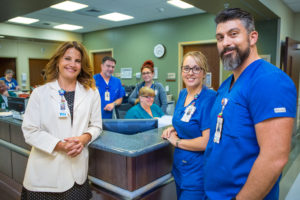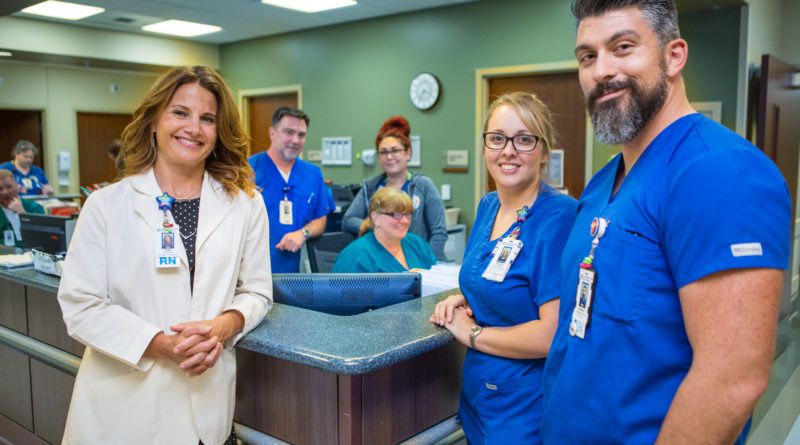The uncertainty of emergency medicine
Story by Catherine Hosman | Photo by Mike Bartoszek
Kari Shulz thrives under chaos.

As the director of the emergency department at Seton Medical Center Harker Heights, and trauma nurse for 17 years of her 20-year nursing career, she is calming presence to her staff when facing the medical emergencies that come through the door of the ED.
The ED sees more than 130 patients each day and Schulz said, “You don’t know what’s going to come through the door.”
“During the first six months of this year we’ve seen more violent trauma,” she continued. “It’s been eye opening. Some of the things we deal with are not fun.”
Shulz is a “boots on the ground” manager who supervises a staff of 65. She handles the day-to-day operations of a busy ED with four Fast Track rooms and 17 beds. More than 54,000 patients pass through the doors of the Seton Medical Center Harker Heights emergency department each year.
She joined SMCHH as trauma coordinator in 2013, and was promoted to her current position in 2014.
A quiet upbringing
Born in Golden Valley, Minnesota, a suburb of Minneapolis, Schulz’s family moved to Forman, North Dakota, when she was 5. “It had less than 500 people,” she said. It was her father’s hometown, the place he was born and reared. She said it was “very Mayberry.”
“People left their keys in their cars in the driveway, doors were never locked,” she recalled.
During those magical years she and her friends spent their after school hours and summer days riding their bicycles throughout the town.
“We were never inside,” she said. “We came inside for meals. There was no technology, no video games. I had 27 people in my graduating class.”
Townspeople looked out for one another and to help parents know where their children were a fire siren rang at 12, 5 and 9 p.m.
“For lunch, supper and curfew,” she said.
And in the harsh North Dakota winters, children still played outside. “We had a ditch in front of our house and my brother would bury me in the snow.”
A self-proclaimed tomboy and avid swimmer, Schulz was just 14 years when she discovered she wanted to be a nurse. Each summer she took a job as a lifeguard at the community pool in Forman. As part of her training, Schulz learned how to administer CPR.
Sitting on top of her perch, overlooking the swimmers, she started thinking about the power of CPR and how it could help save someone’s life. It was that moment that put her on a path to become a nurse.
“Every summer I was a lifeguard, anticipating what’s going to happen,” she said. “It was a huge pool. We had great leaders. I knew it (nursing) was something I wanted to do. I was driven as a kid.”
Seven years earlier, when she was 7 years old, she recalled the time when her grandfather was in the hospital with leukemia. She remembered the nurses comforting her family.
“It’s a sad memory. I was watching those nurses in action,” she said. “They didn’t even know my parents, they had no relationship, yet they were still able to comfort them, help them. That’s the caring aspect. Even if you’ve only met someone for a day, you can help them.”
Schulz worked in the town’s Skid Steer Bobcat Factory after high school graduation. “Dad retired from there and employees’ kids could work for the summer,” she said. “I worked five 12-hour shifts and earned $14 an hour. I did everything from putting on decals to working with power tools and driving a forklift.
“Many classmates went on to work full time,” she continued. “It was easy shift work in a factory. In Forman, you farmed or worked in the factory. This motivated me to go to college.”
She graduated from the University of Mary in Bismark, North Dakota, in 1997. Since there weren’t many nursing jobs available at the time, she began her career as a surgical nurse at Heartland Health Systems in Fargo, North Dakota. A few years later, the hospital was preparing to move to a new location and they were closing the medical surgery floor.
“I wanted to try something different so I moved to the emergency room in 2000,” she said. “I fell in love with it right away. It is my favorite place to work. I love the uncertainty of it. I found that I am calm in stressful situations and thrive under stress, chaos.”
Meeting community needs
More than 50,000 people each year come through the doors of the ED and Schulz said it takes creativity to be able to manage all of those patients quickly and get them out the door. As the community grows, so does the need for a larger emergency department. Schulz said she is hoping for an expansion of the ED.
Emergency medical personnel work under life altering stress because of the types of trauma they see daily and the care they administer. Schulz said it is important to make sure her employees are happy, and that they are always at full staff in the department.
Michael Hales, RN and ICU director at Seton worked with Schulz as the ED manager from 2015 to 2017, before being promoted to his current position. During that time Hales said Schulz was instrumental in changing the staffing ratio in the ED, ensuring that the day shift and the night shift had an equal amount of staff.
“When I got the manager’s position, Kari needed a night shift charge nurse and asked me to work nights,” Hales said. “She said she wouldn’t let me do it myself and she came and worked as the triage nurse.”
Before Schulz got involved with the night shift, Hales said there was less staff and patients waited for “long periods of time.”
“Directors don’t typically come in and work as staff,” he said. “When she came in and worked as staff, that showed her dedication to employees and that’s what got everyone’s loyalty. She leads by example. Employee morale on the night shift went up dramatically. Now we have 90 percent employee retention.”
“You really can’t do anything, take good care of patients, move them out, without a happy engaged staff,” Schulz added. “A happy staff yields happy patients and gets the work done.”
Seton Medical Center Harker Heights
850 W. Central Texas Expressway
Call 254-690-0900
setonharkerheights.net




